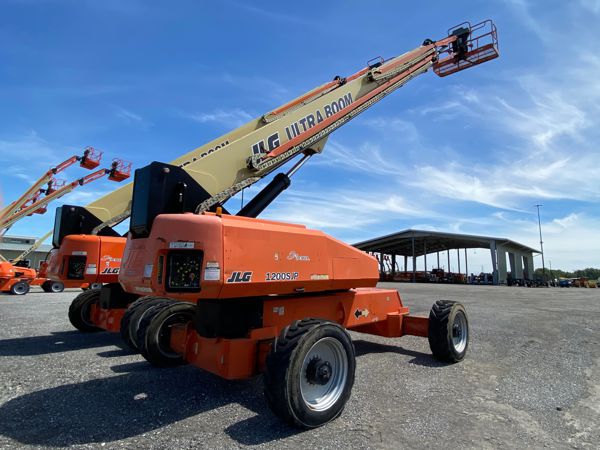Aerial lifts are widely used pieces of equipment for accessing elevated spaces on a platform. They represent a broad category of machinery, which includes various types such as boom lifts, articulating boom lifts, scissor lifts, telescopic boom lifts, and more.
Over the last several decades, more construction firms and job sites have shifted towards using aerial lifts instead of traditional scaffolding and ladders. Aerial lifts offer greater flexibility and better access to challenging areas.
Currently, some of the largest aerial lift manufacturers are JLG and Terex's Genie brands.
Like most machines, aerial lifts come with specific risks. Common injuries and accidents include:
-
Falling when the platform is elevated
-
Objects falling from the elevated platform and injuring someone below
-
Tip-overs
-
Being ejected from the lift platform
-
Structural collapses or failures
-
Electrocution from nearby power lines
-
Getting entangled in moving parts
OSHA has released detailed guidelines for the safe use of aerial lifts on job sites.
Pre-Lift Inspection
It is crucial to inspect your aerial lift before every work shift. Make sure to go through the checklist below and ensure the equipment is functioning properly. Additionally, always adhere to the manufacturer's safety and maintenance recommendations.
-
Vehicle Components:
-
Fluid levels (oil, hydraulic, fuel, and coolant)
-
Fluid leaks
-
Wheels and tires
-
Battery and charger
-
Lower-level controls
-
Horn, gauges, lights, and backup alarms
-
Steering and brakes
-
Lift Components:
-
Operating and emergency controls
-
Personal protective equipment (PPE)
-
Hydraulic, air, pneumatic, fuel, and electrical systems
-
Fiberglass and other insulating components
-
Missing or unreadable placards, warnings, or operational, instructional, and control markings
-
Mechanical fasteners and locking pins
-
Cable and wiring harnesses
-
Outriggers, stabilizers, and other structures
-
Loose or missing parts
-
Guardrail systems
-
Work Zone Inspections:
-
Drop-offs, holes, or unstable surfaces like loose dirt
-
Inadequate ceiling heights
-
Slopes, ditches, or bumps
-
Debris and floor obstructions
-
Overhead electric power lines and communication cables
-
High winds and other severe weather conditions, such as ice
-
The presence of others in close proximity to the work area
Safety Practices While Operating an Aerial Lift
Fall Protection
-
Ensure that access gates and openings are closed.
-
Stand firmly on the floor of the platform with both feet.
-
Avoid climbing on or leaning over guardrails.
-
Do not use planks, ladders, or other devices as a working position.
-
Wear a body harness or a restraining belt with a lanyard attached to the boom or bucket.
-
Do not secure yourself to adjacent structures or poles while in the bucket. If the platform moves, it could eject you.
Operation/Traveling/Loading
-
Do not exceed the load-capacity limits. Consider the combined weight of people, tools, and materials.
-
Do not use the aerial lift as a crane. It is not designed for this purpose - it wears out faster and can lead to injuries.
-
Do not transport objects larger than the platform.
-
Do not drive with the lift platform raised (unless the manufacturer’s instructions allow this).
-
Do not operate lower-level controls unless permission is obtained from the worker(s) in the
lift (except in emergencies)
-
Do not exceed vertical or horizontal reach limits.
-
Do not operate an aerial lift in high winds above those recommended by the manufacturer.
-
Do not override hydraulic, mechanical, or electrical safety devices.
Overhead Protection
-
Be mindful of overhead clearance and overhead objects, including ceilings.
-
Avoid positioning aerial lifts between overhead hazards if possible.
-
Treat all overhead power lines and communication cables as energized, and stay at least 10 feet
away.
-
Ensure that the power utility or power line workers de-energize power lines in the vicinity
of the work.
Aerial Lift Stability
-
Set outriggers on pads or on a level, solid surface.
-
Set brakes when outriggers are used.
-
Use wheel chocks on sloped surfaces when it is safe to do so.
-
Set up work zone warnings, such as cones and signs, when necessary to alert others.
Group Discussion Topics
-
Is the aerial lift in good condition (for example, tires, hydraulic lines, signage, etc.)? Perform a visual inspection daily.
-
Are there any potential risks at elevated levels nearby (for instance, power lines, gas pipes, etc)?
-
How safe is the workplace floor surface to operate an aerial lift?
-
How many persons will be on the platform? Does the combined weight of the persons and their gear exceed weight limits?
-
What could cause the scissor lift to tip over?
Find Similar Articles By Topic
#construction
#material handling
#toolbox talks
#aerial lifts
#Terex
#JLG
Aerial lifts have become essential tools in modern construction and industrial settings. Their versatility and ability to reach otherwise inaccessible areas make them indispensable for many projects. However, their operation requires strict adherence to safety protocols to prevent accidents and injuries. Regular inspections and operator training are key components of maintaining a safe work environment.
When operating aerial lifts, always prioritize safety by ensuring proper maintenance checks and following manufacturer guidelines. Remember that these machines are powerful tools that demand respect and caution. Always communicate with your team and ensure everyone is aware of the risks involved. By doing so, you can help prevent accidents and keep your worksite safe.
Flywheel
Flywheel,Hand Held Compressor,Water Compressor Machine,Gas Booster Compressor
Permanent Machinery Co., Ltd. , https://www.jshjcompressor.com
